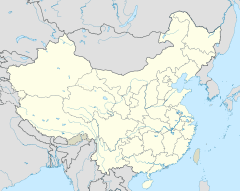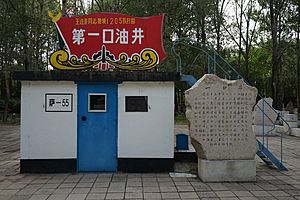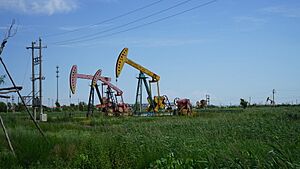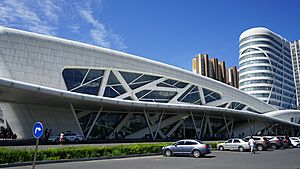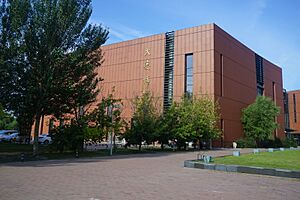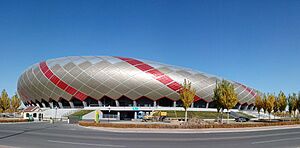Daqing facts for kids
Quick facts for kids
Daqing
大庆市
|
|
|---|---|
|
Prefecture-level city
|
|
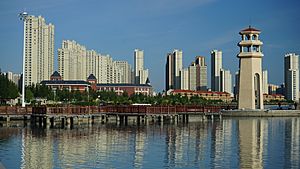
Around Sanyong Lake, 2017
|
|
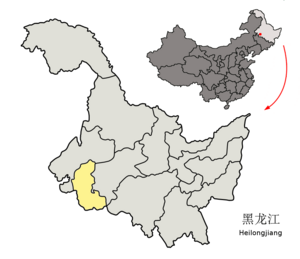
Location of Daqing City (yellow) in Heilongjiang (light gray) and China
|
|
| Country | People's Republic of China |
| Province | Heilongjiang |
| County-level divisions | 9 |
| Government | |
| • Type | Prefecture-level city |
| Area | |
| • Prefecture-level city | 22,161 km2 (8,556 sq mi) |
| • Urban | 5,107 km2 (1,972 sq mi) |
| • Metro | 2,734.6 km2 (1,055.8 sq mi) |
| Elevation | 149 m (489 ft) |
| Population
(2020 census)
|
|
| • Prefecture-level city | 2,781,562 |
| • Density | 125.5161/km2 (325.085/sq mi) |
| • Urban | 1,754,655 |
| • Urban density | 343.58/km2 (889.86/sq mi) |
| • Metro | 1,574,389 |
| • Metro density | 575.729/km2 (1,491.132/sq mi) |
| GDP | |
| • Prefecture-level city | CN¥ 298.4 billion US$ 47.9 billion |
| • Per capita | CN¥ 107,419 US$ 17,247 |
| Time zone | UTC+8 (China Standard) |
| Postal code |
163000
|
| Area code(s) | 0459 |
| ISO 3166 code | CN-HL-06 |
| Licence plates | 黑E |
| Climate | Dwa |
| Daqing | |||||||||
|---|---|---|---|---|---|---|---|---|---|

"Daqing", as written in Chinese
|
|||||||||
| Chinese name | |||||||||
| Simplified Chinese | 大庆 | ||||||||
| Traditional Chinese | 大慶 | ||||||||
| Postal | Taching | ||||||||
| Literal meaning | Great Celebration | ||||||||
|
|||||||||
| Mongolian name | |||||||||
| Mongolian Cyrillic | Дачин хот | ||||||||
| Mongolian script | ᠳᠠᠴᠢᠩ ᠬᠣᠲᠠ | ||||||||
|
|||||||||
| Manchu name | |||||||||
| Manchu script | ᡩᠠᡴᠠᠩ ᡥᠣᡨᠣᠨ | ||||||||
| Romanization | Daking hoton | ||||||||
Daqing (simplified Chinese: 大庆; traditional Chinese: 大慶; pinyin: Dàqìng) is a city in the western part of Heilongjiang province, People's Republic of China. Its name means "Great Celebration." This name honors the tenth anniversary of the People's Republic of China. Daqing is famous as the "Oil Capital of China." It grew very quickly after oil was found there in 1959.
The city's population was about 2.78 million people in 2020. About 1.57 million of these people live in the main city area. This area includes four of its five urban districts: Sartu, Longfeng, Ranghulu, and Honggang.
Contents
History of Daqing
The area where Daqing is located was not very important until the Qing dynasty. It was mostly a hunting ground for tribes. The region started to develop a little more in 1898. This was when the Russian Empire built the Chinese Eastern Railway through the area. A train station was built in Sartu, which is now a district of Daqing.
Oil Discovery and City Founding
The big change for Daqing happened in 1959. That year, a huge oil field was discovered. This was part of a large search for oil across the Northeast China Plain. Drilling for oil began in 1958.
A new town was created in 1959. It was built to house the workers who were drilling for oil and gas. It also hosted industries that used the oil and chemicals. This happened just before China's 10th anniversary.
A Model for Industry
Building the Daqing oil field was a huge success. This was true even with tough weather and limited supplies. The Chinese government used Daqing as a model for other industries. It showed how hard work could lead to success.
The oil field was also very important for China's economy. Without the oil from Daqing, China would have had very little crude oil. This was because the Soviet Union stopped supplying oil to China.
Growth and Changes
Early plans for Daqing focused on building a "new socialist mining district." This meant husbands would work in industry and wives in farming. The idea was to create a balanced community.
In 1960, Anda City was set up to manage the oil field area. Later, in 1964, the city of Anda became a special administrative region. The oil field continued to drive economic growth.
The Daqing Oil District officially became a city in 1980. Its first plan aimed to make it a "new industrial city." It focused on spreading out settlements but with some main centers.
Later, in 1989, the city's plan changed. It aimed to build an oil city centered in Sartu, Dongfeng, and Longfeng. This plan moved towards having more central urban areas.
By 1994, Daqing's population reached one million people. After the mid-1990s, new building in Sartu stopped. This was to make more space for oil production. City construction then moved to other areas.
Since it was founded, Daqing has been seen as a great example. The Chinese government has praised its industry and healthcare.
Learn from Daqing in Industry
Mao Zedong issued a famous saying in the 1960s: "Learn from Daqing in Industry." This shows how important Daqing was to China's industry. This slogan encouraged people to follow Daqing's example in industrial production.
A film called Entrepreneurial Pioneers was made in the 1970s. It tells the story of Daqing's early days. Daqing was the model for industry. For farming, the model was a village called Dazhai.
Administrative Divisions
Daqing is divided into 9 main areas. These include 5 districts, 3 counties, and 1 autonomous county.
| Map | |||||
|---|---|---|---|---|---|
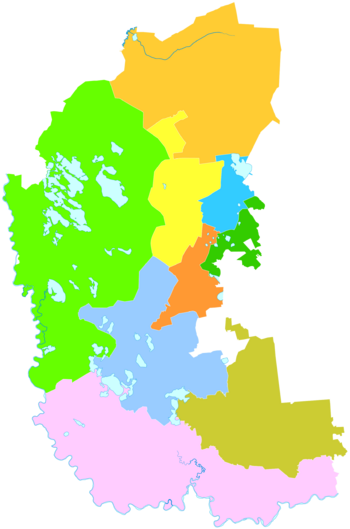
Sartu
Longfeng
Ranghulu
Datong
Honggang
Zhaozhou
County Zhaoyuan
County Lindian
County Dorbod
County |
|||||
| Name | Simplified Chinese | Hanyu Pinyin | Population (2010 census) |
Area (km2) |
Density (/km2) |
| Sartu District | 萨尔图区 | Sà'ěrtú Qū | 328,808 | 549 | 599 |
| Longfeng District | 龙凤区 | Lóngfèng Qū | 352,404 | 510 | 691 |
| Ranghulu District | 让胡路区 | Rànghúlù Qū | 564,534 | 1,394 | 405 |
| Datong District | 大同区 | Dàtóng Qū | 234,557 | 2,235 | 105 |
| Honggang District | 红岗区 | Hónggǎng Qū | 169,522 | 812 | 209 |
| Zhaozhou County | 肇州县 | Zhàozhōu Xiàn | 387,463 | 2,445 | 158 |
| Zhaoyuan County | 肇源县 | Zhàoyuán Xiàn | 388,828 | 4,198 | 93 |
| Lindian County | 林甸县 | Líndiàn Xiàn | 244,578 | 3,591 | 68 |
| Dorbod Mongol Autonomous County | 杜尔伯特蒙古族自治县 | Dù'ěrbótè Měnggǔzú Zìzhìxiàn | 233,838 | 6,427 | 36 |
Climate
Daqing is in the northern part of the world. It has a humid continental climate. This means it has cold winters and warm summers. The weather is affected by winds from Siberia and East Asia.
Winters are very cold, sometimes with snow. Spring and autumn have strong winds. Most of the rain falls in the summer months. The temperature can change a lot in one day, especially during the growing season. The average temperature in January is about -18.5°C (negative 18.5 degrees Celsius). In July, it's about 23.3°C. The city gets about 2,726 hours of sunshine each year.
| Climate data for Daqing (2005–2020 normals) | |||||||||||||
|---|---|---|---|---|---|---|---|---|---|---|---|---|---|
| Month | Jan | Feb | Mar | Apr | May | Jun | Jul | Aug | Sep | Oct | Nov | Dec | Year |
| Mean daily maximum °C (°F) | −11.7 (10.9) |
−6.9 (19.6) |
2.9 (37.2) |
13.5 (56.3) |
21.5 (70.7) |
26.7 (80.1) |
28.5 (83.3) |
26.9 (80.4) |
21.5 (70.7) |
12.3 (54.1) |
−0.3 (31.5) |
−10.3 (13.5) |
10.4 (50.7) |
| Daily mean °C (°F) | −16.5 (2.3) |
−12.2 (10.0) |
−2.5 (27.5) |
7.8 (46.0) |
15.8 (60.4) |
21.4 (70.5) |
24.0 (75.2) |
22.2 (72.0) |
16.0 (60.8) |
6.9 (44.4) |
−4.8 (23.4) |
−14.6 (5.7) |
5.3 (41.5) |
| Mean daily minimum °C (°F) | −20.6 (−5.1) |
−17.0 (1.4) |
−7.5 (18.5) |
2.2 (36.0) |
10.3 (50.5) |
16.4 (61.5) |
19.6 (67.3) |
17.9 (64.2) |
11.1 (52.0) |
2.2 (36.0) |
−8.6 (16.5) |
−18.3 (−0.9) |
0.6 (33.2) |
| Average precipitation mm (inches) | 2.4 (0.09) |
3.8 (0.15) |
8.8 (0.35) |
18.9 (0.74) |
49.0 (1.93) |
100.7 (3.96) |
145.8 (5.74) |
97.3 (3.83) |
50.3 (1.98) |
19.1 (0.75) |
6.2 (0.24) |
5.9 (0.23) |
508.2 (19.99) |
| Average precipitation days (≥ 0.1 mm) | 3.6 | 2.7 | 4.3 | 5.7 | 9.6 | 13.5 | 13.1 | 11.3 | 7.8 | 4.8 | 4.1 | 5.3 | 85.8 |
| Average snowy days | 5.5 | 4.9 | 5.5 | 2.3 | 0.1 | 0 | 0 | 0 | 0 | 1.1 | 5.5 | 8.1 | 33 |
| Average relative humidity (%) | 64 | 58 | 51 | 44 | 52 | 64 | 73 | 73 | 65 | 56 | 60 | 66 | 61 |
| Mean monthly sunshine hours | 181.6 | 194.2 | 237.5 | 230.9 | 235.3 | 220.9 | 211.8 | 211.9 | 222.6 | 199.8 | 158.7 | 152.4 | 2,457.6 |
| Percent possible sunshine | 65 | 66 | 64 | 56 | 51 | 47 | 45 | 49 | 60 | 60 | 57 | 58 | 57 |
| Source: China Meteorological Administration | |||||||||||||
People of Daqing (Demographics)
Daqing has about 2.9 million people. Most of them are Han Chinese. There are also 31 other ethnic groups living there. These include Manchu, Mongolian, Korean, and Hui people.
Economy
Daqing's economy relies heavily on petroleum and related businesses. The Daqing Oil Field is China's largest oil field. It is also the fourth most productive in the world. Oil production makes up a big part of the city's economy.
In 2011, Daqing's total economic output (GDP) was about 374 billion Chinese yuan. This was a 12.1% increase from the year before. Farming, fishing, and forestry also grew. Industries like manufacturing and construction also saw increases.
Trading with Other Countries
Daqing exports over 10 million tons of crude oil every year. It also sends out more than 160 different oil-based products. These include things like wax, ethylene, and tar oil. They are sent to over 10 countries and regions. Some of these are the US, UK, Thailand, and Hong Kong.
In 2011, Daqing's total trade with other countries was about $2.16 billion. Its main exports are petrochemical products, building materials, and processed foods. It also exports office furniture and electronic equipment.
Banks and Money
By the end of 2006, Daqing had 32 banking institutions. No foreign banks were operating there at that time. In 2011, people's savings in banks totaled about 170.5 billion Chinese yuan. The local banks help a lot in growing Daqing's oil industry and new businesses.
Many major banks serve Daqing. These include the Industrial and Commercial Bank of China and the Bank of China.
Transportation
Trains
Daqing is an important train center in western Heilongjiang province. It is where the Harbin-Manzhouli Railway and Tongliao-Ranghulu Railway meet. Daqing has three main train stations. They are Daqing station, Daqing West station, and Daqing East station. Trains from Daqing connect the city to Beijing, Harbin, Dalian, and other Chinese cities. A new high-speed train line also stops at Daqing West and Daqing East stations.
Airport
Daqing Sartu Airport opened on September 1, 2009. You can fly from Daqing to many big cities. These include Beijing, Chengdu, Guangzhou, Hangzhou, Qingdao, and Shanghai.
Highways
Daqing is connected to China's national highway system. The G45 Daqing–Guangzhou Expressway and G10 Suifenhe-Manzhouli Expressway pass through or near the city.
Culture
Daqing Spirit
Daqing has a special culture called the "Daqing Spirit, the Daqing People." This spirit means being very dedicated to national goals. It also means living simply and being self-sufficient. It encourages a mix of city and country living. This idea was seen as a perfect example of a balanced society.
An article in People's Daily in 1964 praised the success of Daqing oil workers. It was called "Daqing Spirit, Daqing People." This article was very important. It compared Daqing to Yan'an, a famous revolutionary place.
Wang Jinxi (Chinese: 王进喜; pinyin: Wáng Jìnxǐ) was a famous oil worker. He was known as "Iron Man" Wang. He led a drilling team at the Daqing Oilfield. He became a national hero for his work in China's oil industry. Daqing was made a model for industry by the government in the 1960s. Many films were made to show the hard work of Daqing and its people.
In 1964, a director named Sun Weishi and her husband lived with the oil workers in Daqing. She later wrote an article praising the people of Daqing. She also created a play called The Rising Sun. It was based on the experiences of people in Daqing, especially the women.
Sports
The most popular sport in Daqing is association football (soccer). The biggest sports place in the city is the Daqing Olympic Park Stadium. It can hold 32,000 people.
Sister Cities
In China
Around the World
 East London, Eastern Cape, South Africa
East London, Eastern Cape, South Africa Calgary, Alberta, Canada
Calgary, Alberta, Canada Tyumen, Tyumen Oblast, Russia
Tyumen, Tyumen Oblast, Russia Chungju, North Chungcheong, South Korea
Chungju, North Chungcheong, South Korea
See also
 In Spanish: Daqing para niños
In Spanish: Daqing para niños



